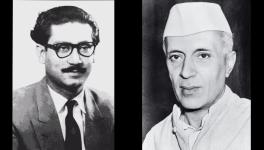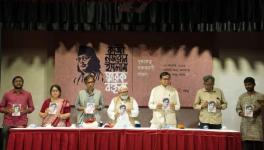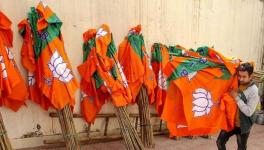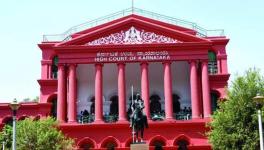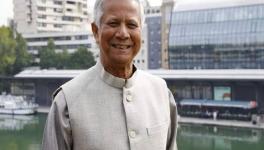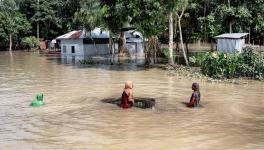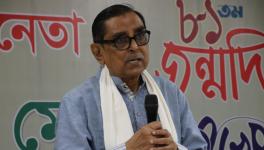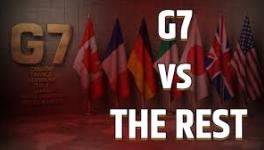Resilience of Dhaka’s Shaheed Minar: Will it See Another Spring?
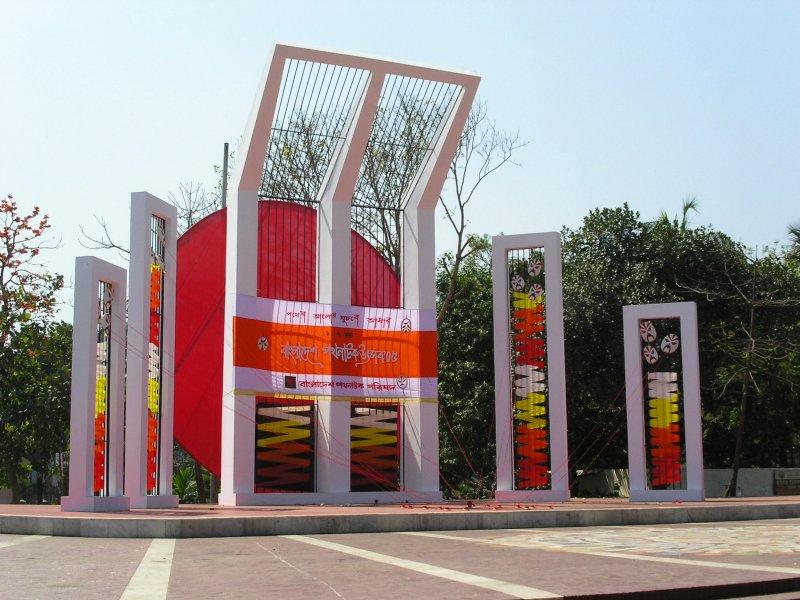
Shaheed Minar, Dhaka. (Image Credit: Wikimedia Commons/Karl Ernst Roehl)
We are wild as the storm
We are restless as the spring
We are fearless like god and generous like nature.
We are as free as the sky
We are Bedouin, the deserts wandering tribe.
We know no king
nor any king's laws,
We submit to no rule or regulation,
We are born free with it mind'
open as the blossoming lotus.
We are the murmuring flood tide of the sea
and the warbling waters of the mountain spring
---Kazi Nazrul Islam
The once vibrant nights of Dhaka, with their dazzling neon lights, have given way to a city shrouded in darkness and the stench of violence. The streets, once adorned with the grandeur of Mughal architecture, Islamic art, Buddhist heritage, and towering temples, now stand eerily desolate. Dhaka, a city that has nurtured countless talents—including Jyoti Basu, an eminent leader of India’s communist movement and former Chief Minister of West Bengal—now bears the scars of its troubled history.
The collapse of Sheikh Mujibur Rahman’s legacy and the current upheaval serve as stark reminders of the precariousness of Bangladesh’s hard-won independence. The land that once symbolised resilience and hope now wrestles with uncertainty, as the echoes of past struggles resurface with a vengeance.
In August 1975, just five years after the birth of Bangladesh, the nation’s founding father, President Sheikh Mujibur Rahman, was brutally assassinated in a military coup. Now, nearly half a century later, the world watches in disbelief as his daughter, Sheikh Hasina, faces a similar fate—ousted in another August coup.
Sheikh Mujibur Rahman, the charismatic leader who rose from the ashes of East Pakistan, was the architect of modern Bangladesh. His vision and leadership inspired fighters worldwide. Yet, the haunting image of his monumental statue being toppled on television, made one reflect on the fragility of people's power in the face of relentless political turmoil.
When public sentiment against the Hasina government reached a boiling point, the streets of Dhaka became scenes of vandalism, with statues and sculptures ruthlessly destroyed. These acts of desecration seem to symbolise the erasure of history from the collective consciousness. The question arises: can a nation’s cultural heritage, once broken, ever truly be restored?
The outcry against Hasina’s rule—she being the daughter of Mujibur Rahman and the current Prime Minister of Bangladesh—reached such intensity that even the Sheikh Mujibur Rahman Memorial Museum on Dhanmondi Road was set ablaze. Once considered a pilgrimage site, this house, where the seeds of Bangladesh’s formation were sown and where strategic discussions were held during the struggle against the Pakistani army, is now engulfed in flames of unrest.
Mujibur Rahman, born in 1920 in Gopalganj village, India, rose through the ranks of political activism, first in the Muslim League and later as a leader of the East Pakistan Muslim Students League. He ultimately became a pivotal figure in the Muslim Awami League, serving in both the provincial assembly and the cabinet. His leadership during the 1971 Bangladesh Liberation War elevated him to the status of a world leader, revered for his role in securing Bangladesh’s independence.
As Bangladesh once again finds itself in the throes of political turmoil, the echoes of past struggles reverberate with renewed urgency. The deep-seated neglect by the government toward the eastern province of the former undivided Pakistan was the foundation of the Bengali people’s movement. Pakistan’s treatment of the region as a colonial outpost sparked the 1952 Dhaka University agitation for the recognition of the Bengali language, a movement that was brutally suppressed by the Pakistani authorities, resulting in the martyrdom of many students.
This movement, remembered as 'February 21' or 'Ekushey Pathik,' became a symbol of resistance. Two decades later, in 1971, the struggle culminated not in autonomy but in the birth of a new nation. The Bengali liberation struggle, marked by bloodshed rather than peaceful protest, witnessed horrific atrocities committed by Pakistan's military leaders, Yahya Khan and General Tikka Khan. The violence forced millions of Bengalis to seek refuge in India, leaving an indelible mark on the nation’s history.
In response to Pakistan's aggression, former military personnel and anti-Pakistani rebels in East Pakistan formed a people's army known as the Mukti Bahini. This force played a pivotal role in countering Pakistan during the Bangladesh Liberation War. In December 1971, Pakistan launched a series of airstrikes on Indian airbases, ranging from Avantipur in Kashmir to Rajasthan.
India swiftly retaliated, and after a brief 13-day conflict, Pakistan surrendered. The geopolitical tensions escalated when the United States dispatched nuclear-armed ships to the Bay of Bengal in support of Pakistan, with Britain also sending an aircraft carrier. However, the Soviet Union firmly stood by India, signaling its readiness to defend India if American and British forces intervened. This moment marked a significant chapter in the India-Soviet relationship, highlighting the deep bond between India and Bangladesh.
The seeds of resistance in East Pakistan were sown much earlier, with students leading a vibrant protest against Pakistan's oppressive language policy, which sought to marginalise the Bengali language. The Shaheed Minar, erected at Dhaka University, stands as a powerful memorial to this resistance. The historic 1952 student strike, known as Ekushey February or the February 21 movement, is commemorated annually with great fervour. Across Bangladesh, art and cultural gatherings, national book festivals, and historical exhibitions honor this day. On this day, all eyes turn to the Shaheed Minar, as thousands, including Prime Minister Sheikh Hasina, gather from across the country and abroad. Leaders, officials, and citizens alike pay floral tributes, while some sing, dance, and chant slogans. They unite under the banner of Bengali identity, transcending religion, caste, and regional differences. The legacy of Mujibur Rahman’s iconic speech on March 7, 1971, delivered at the height of the freedom struggle, continues to inspire and resonate throughout history.
"Our upcoming struggle is for human liberation. Let Bengal win. We have already shed a lot of blood for it, and if needed, we will shed even more. By the grace of God, we will be liberated. Turn every house into a fortress. Make whatever you have a weapon." These were the powerful words that fueled the birth of modern Bangladesh, a nation forged in the crucible of war.
The journey to independence was marked by immense sacrifice. Following the brutal conflict, Mujibur Rahman emerged as the country's first President, with Tajuddin Ahmad serving as Prime Minister. However, the promise of a new era was violently disrupted in 1975 when a military coup claimed the lives of Mujibur Rahman and his family. In the aftermath, Ziaur Rahman seized power but met a similar fate, being assassinated in 1981. The political landscape continued to shift, with Lieutenant General Hussain Muhammad Ershad taking control in 1982 through another coup. His regime eventually crumbled under the weight of mass protests against corruption, leading to his resignation in 1990.
The following years saw Khaleda Zia rise to power as Prime Minister through elections in 1991 and again in 2001. Sheikh Hasina has since become a dominant force in Bangladeshi politics, serving as Prime Minister in 1996, 2009, 2014, 2019, and 2024. The period between 2006 and 2008 was particularly turbulent, marked by intense internal strife and strikes. Today, Bangladesh's political landscape remains dynamic, with the Awami League, Bangladesh Nationalist Party (BNP), Jatiya Party, and the Communist Party of Bangladesh holding significant influence. Meanwhile, the banned Jamaat-e-Islami continues to be a potent force within the nation's socio-political sphere.
Since 2014, the Awami League has faced widespread criticism for allegedly rigging general elections and persecuting opposition leaders. Under Sheikh Hasina's administration, corruption and abuse of power became pervasive, leading to rampant unemployment. By July 2024, a student strike over the issue of reservation escalated dramatically. Roads and railways were blocked, and the government responded with brutal force. The strike was sparked by the decision to withdraw a 30% reservation for Bangladeshi liberation fighters. Although the High Court initially upheld the reservation, a Supreme Court ruling reduced it, fueling widespread unrest. Protesters held the government responsible for the deaths that occurred during the demonstrations and demanded compensation.
On July 1, university students began their protest by blocking roads and railways, demanding the revoking of the reservation policy. Sheikh Hasina, who had secured her fifth term in a controversial election in January, initially dismissed the protest as a waste of time. Allegations of election fraud had plagued her victory, with the Communist Party of Bangladesh and the main opposition, the Bangladesh Nationalist Party, boycotting the election. The Bangladesh Workers' Party, a leftist ally of the Awami League, was the only significant opposition. Jamaat-e-Islami, banned for its extremist policies, was excluded from the electoral process.
The government's response to the student strike was severe. Police, aided by members of the Awami League's affiliated sports team, confronted the protesters, resulting in casualties on both sides. On August 4, the violence peaked with hundreds of people killed, including 14 policemen. Former Army Chief Iqbal Karim Bhuyal publicly urged the government to withdraw troops and restore peace, condemning the loss of life. The current Army Chief declared the military's allegiance to the people, leading to a wave of rebellion as students and citizens began seizing police stations and government offices. In the ensuing chaos, a television station was set ablaze. Sheikh Hasina narrowly escaped, fleeing in an Air Force plane, aided by army personnel loyal to her, just as protesters closed in on the Prime Minister's residence.
Sheikh Hasina has brought an adventurous public life to a close in a manner as tragic as it is unforeseen. Widely regarded as a Prime Minister who has spearheaded numerous milestones in economic development, she demonstrated exceptional diplomatic acumen, skillfully maintaining balanced relations with both India and China. Additionally, her firm stance against religious extremism earned her considerable respect on the international stage.
However, where did her leadership falter? Once her government and the Awami League consolidated their power, an echo chamber formed around her, filled with sycophants rather than sincere advisors. This insular environment led to her personal influence becoming as unassailable as the infamous adage "Indira is India, India is Indira." Corruption flourished under her watch, particularly among those aligned with the Awami League. Critics were met with an iron fist, and Hasina’s strategic use of undemocratic tactics to secure electoral victories drew widespread condemnation both domestically and internationally.
The tipping point came with the student protests, which erupted in response to high unemployment and demands for changes in the reservation policy, eventually evolving into a massive civil uprising. The government's heavy-handed approach, marked by violent crackdowns by police and Awami League loyalists, further inflamed the situation. Adding fuel to the fire, Hasina’s characterisation of the protesters as "Razakars"—a term historically associated with the collaborators of West Pakistani forces during the Bangladesh Liberation War, infamous for their brutalities—was a grave misstep that deepened public outrage and tarnished her legacy.
In the complex political landscape of Bangladesh, the public narrative surrounding Hasina's departure is being questioned by some. Contrary to claims that her downfall was tied to an anti-reservation movement, the roots of the unrest are deeper and more intricate.
The 30% reservation policy for families of freedom fighters, initially introduced in 1972 and later extended to include their grandchildren in 2010, was rescinded in 2018. This repeal led to student protests following a High Court ruling that sought to restore the policy. However, the protesters did not demand the reinstatement of the original 30% quota. Instead, they called for a revision of the policy. The Supreme Court responded by reducing the quota from 30% to 5%, thereby decreasing the total reservation from 56% to 7%. Satisfied with this outcome, the students initially retreated to their campuses.
In June 2024, protests erupted in Bangladesh in response to the High Court's reinstatement of a quota system for government jobs. This system reserved one-third of civil service positions for the children of freedom fighters who had participated in the country's 1971 liberation war. The reinstatement of the quota, which had been abolished by the Hasina government in 2018, triggered widespread dissatisfaction among students and young professionals. They argued that the quota system limited opportunities for those without political connections and hindered merit-based recruitment. The protests, which began on university campuses, quickly escalated into nationwide demonstrations.
The government's handling of the protests faced significant criticism, leading to further unrest. In a key development, the Supreme Court intervened, suspending and ultimately dismissing the High Court's order. The apex court mandated that 93 percent of government jobs be filled based on merit, marking a significant victory for the protesters. These events underscore the deep political and social divisions in Bangladesh, with the quota system acting as a catalyst for broader discontent.
Yet, the situation escalated dramatically when the protests reignited, now demanding Sheikh Hasina’s resignation. Reports suggest that the movement was infiltrated by groups opposed to Bangladesh's independence, including organizations like Jamaat-e-Islami. The growing unrest, which evolved into a massive popular uprising, eventually led to the withdrawal of support from both the police and the army, forcing Sheikh Hasina to step down. Her departure marks the end of another leader who, disregarding democratic principles, attempted to crush a student-led movement, only to be overpowered by the tide of history.
With Sheikh Hasina's resignation, Bangladesh enters an uncertain phase. In an extraordinary turn of events, the largely ceremonial president dissolved Parliament after consulting with the military and student representatives. Following the students' suggestion, 83-year-old Nobel laureate Muhammad Yunus was appointed as the new prime minister. Yunus, renowned for his pioneering work in poverty alleviation through microloans with the Grameen Bank, became a symbol of a new era. His past conflict with Hasina, who had attempted to imprison him over alleged financial crimes, highlighted the stark contrast between the two leaders. Hasina's most grievous accusation against Yunus was his acceptance of Nobel prize money and book royalties—a charge that seemed trivial in comparison to the broader struggles facing the nation.
Hasina served as the Prime Minister of Bangladesh for 20 years across two terms. Had she completed her term through the 2024 election, she would have made history as the first leader to serve 20 consecutive years, steering Bangladesh for a quarter of a century. However, her swift fall from grace—despite her reputation as the "Iron Lady"—illustrates how quickly public sentiment can turn, forcing even the most formidable leaders to abandon their posts and flee.
The complacency in addressing the pressing issues faced by the people has played a significant role in the current challenges facing the government. While Hasina has undeniably contributed to Bangladesh's economic growth, the situation is nuanced. Bangladesh, distinct from Sri Lanka, outperforms India in terms of per capita income, the Human Development Index, and economic growth, with an unprecedented boom in the textile sector. However, 20% of Bangladesh's population—approximately 34 million people—remains unemployed, with a large portion of the population being young. This has allowed organisations like Jamaat-e-Islami to exploit the government's inability to address these concerns effectively.
Jamaat-e-Islami, along with its backer, the US, has a vested interest in undermining Sheikh Hasina’s secular government, which has maintained the Hindu minority’s integration into the mainstream. A shift in power in the interim government could strain Bangladesh's friendly relations with India.
The political landscape in Bangladesh is at a critical juncture, and the form that the alternative political system takes is of paramount importance. The greatest concern is ensuring that the current situation is not exploited by Right-wing extremist forces. The Communist Party of Bangladesh has emphasised the need for vigilance in this regard.
There is also the looming possibility of increased military involvement, similar to what was once seen in West Pakistan. The spectre of American and CIA interference is a constant reminder of global powers looking to gain from instability, as was evident during the Bangladesh Liberation War when the US threatened India and the freedom fighters with the deployment of the nuclear-armed 7th Fleet. India’s government must craft its response to the unfolding situation in Bangladesh with careful consideration, ensuring that all major political parties are on board, and adhering to the principles of the non-alignment movement that has long guided Indian foreign policy.
Jamaat-e-Islami, which opposed Bangladesh's liberation alongside Pakistan, has no regard for democracy and seeks to establish Islamic rule. Their influence was evident in the all-party meeting convened by Army Chief Waqar Usman, which notably excluded Left-wing parties like the Workers' Party and the Communist Party. Instead, the banned Jamaat-e-Islami, BNP, and the Jatiya Party (led by HM Ershad) were given a seat at the table.
The announcement of BNP leader Khaleda Zia’s release from jail further suggests that Jamaat-e-Islami may play a dominant role in the interim government, with the backing of the United States. The meetings between US diplomats and Jamaat-e-Islami leaders ahead of the January elections indicate the seriousness of this alliance.
Sheikh Hasina's decision to resign as Prime Minister and leave the country, driven by self-serving interests, has paved the way for a return to military rule in Bangladesh. This development is concerning not only for Bangladesh but also for India, especially as tensions in Kashmir escalate. Prime Minister Narendra Modi’s recent visit to Bangladesh in June underscores the strategic importance of maintaining stability in the region. With Bangladesh potentially coming under military control, the coming days pose significant challenges not only for the country itself but for the broader South Asian region as well.
The Indian media's portrayal of the situation in Bangladesh as primarily a Hindu protection issue is both misleading and detrimental to understanding the true nature of the crisis. The unrest in Bangladesh is not just a religious conflict but a matter of significant national security for India, with serious implications for our borders and internal stability. By framing it as a Hindu-Muslim issue, the Sangh Parivar and much of the national media are diverting attention from the broader geopolitical concerns. This narrative seems to align with American interests, reducing the complex situation to a mere communal conflict.
It is concerning that while we recognise US involvement in uprisings in countries like Venezuela and Bolivia, leading to the overthrow of leaders like Nicolas Maduro and Evo Morales, we fail to see similar patterns in Bangladesh. The recent events in Bangladesh bear the hallmarks of a US-sponsored colour revolution, akin to those that led to devastating consequences in Libya, Iraq, and Afghanistan. The potential outcomes for Bangladesh could be similarly dire. While much of the Indian media is sidestepping the real issues, it is reassuring that outlets like Doordarshan have highlighted the significant role of American influence in these developments.
In a complex geopolitical maneuver, the US appears to have been orchestrating efforts to undermine Sheikh Hasina, who maintains strong ties with India, China, and Russia, and to install a government more amenable to its interests. The involvement of Western powers, including the US, in bringing Yunus into an advisory role in the interim government underscores this influence.
Additionally, Hasina’s exclusion from the US-organised democracy summit and American representatives’ engagement with leaders of Jamaat-e-Islami—a party banned under Hasina’s regime—raise questions about the motivations behind these actions. The US's dissatisfaction with Hasina's integration of minority Hindus and her vocal opposition to extremist Islamist factions could be contributing factors.
Historically, the US, Pakistan, and Jamaat-e-Islami have aligned against Indian interests, and any detrimental impact on these interests would reflect poorly on Indian foreign policy. Despite the significant foreign intervention and the controversial involvement of Jamaat-e-Islami, it was ultimately the widespread popular discontent with Hasina's perceived undemocratic and corrupt governance that led to her ouster. In this critical moment, it is imperative for secular forces to unite to foster peace and stability in Bangladesh.
As Kazi Nazrul Islam's evocative verses celebrate the indomitable spirit of freedom and resilience, the present turmoil in Bangladesh casts a shadow over this cherished symbol of resistance. In the heart of Dhaka, where the Shaheed Minar once stood as a beacon of hope and defiance, the echoes of past struggles resonate with renewed urgency. Amidst political upheaval and unrest, the question lingers: will the vibrant spirit of spring and the ideals of liberation continue to flourish, or will the scars of history dim the light of this enduring monument?
The writer is a professional engineer based in Kerala. The views are personal.
Get the latest reports & analysis with people's perspective on Protests, movements & deep analytical videos, discussions of the current affairs in your Telegram app. Subscribe to NewsClick's Telegram channel & get Real-Time updates on stories, as they get published on our website.









